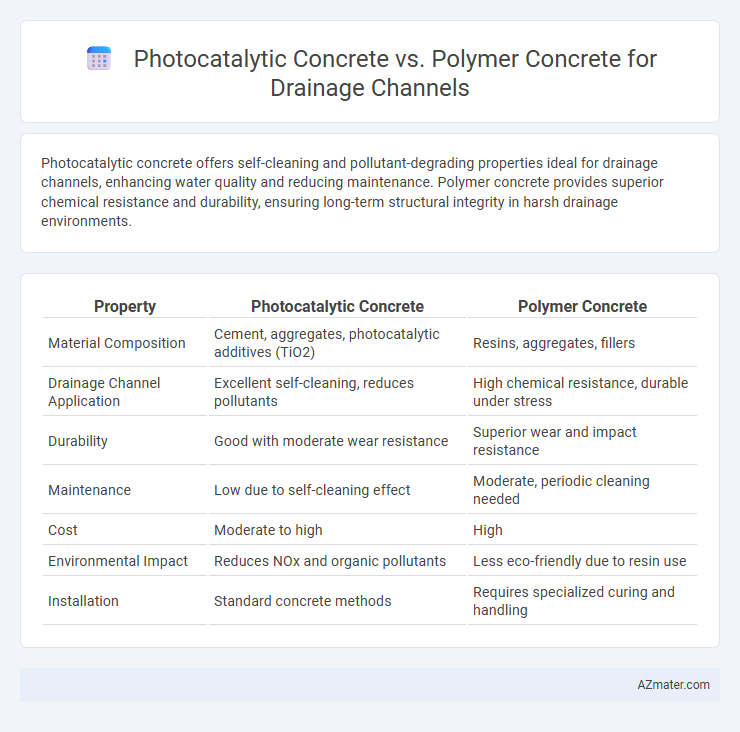Photocatalytic concrete offers self-cleaning and pollutant-degrading properties ideal for drainage channels, enhancing water quality and reducing maintenance. Polymer concrete provides superior chemical resistance and durability, ensuring long-term structural integrity in harsh drainage environments.
Table of Comparison
| Property | Photocatalytic Concrete | Polymer Concrete |
|---|---|---|
| Material Composition | Cement, aggregates, photocatalytic additives (TiO2) | Resins, aggregates, fillers |
| Drainage Channel Application | Excellent self-cleaning, reduces pollutants | High chemical resistance, durable under stress |
| Durability | Good with moderate wear resistance | Superior wear and impact resistance |
| Maintenance | Low due to self-cleaning effect | Moderate, periodic cleaning needed |
| Cost | Moderate to high | High |
| Environmental Impact | Reduces NOx and organic pollutants | Less eco-friendly due to resin use |
| Installation | Standard concrete methods | Requires specialized curing and handling |
Introduction to Modern Drainage Channel Materials
Photocatalytic concrete incorporates titanium dioxide to enhance self-cleaning and pollutant-degrading properties, making it ideal for eco-friendly drainage channels. Polymer concrete offers superior chemical resistance, high strength, and durability, which are essential for demanding drainage environments exposed to aggressive substances. Both materials represent advancements over traditional concrete by addressing sustainability, maintenance, and longevity in modern drainage infrastructure.
Understanding Photocatalytic Concrete
Photocatalytic concrete incorporates titanium dioxide (TiO2) that actively breaks down pollutants through light-induced chemical reactions, enhancing self-cleaning and environmental purification in drainage channels. This concrete type is especially effective in reducing nitrogen oxides (NOx) and organic contaminants, improving urban air quality compared to polymer concrete which primarily provides chemical and mechanical resistance. The photocatalytic process also helps maintain channel efficiency by preventing clogging from organic debris without compromising structural integrity.
Exploring Polymer Concrete Composition
Polymer concrete for drainage channels typically consists of a thermosetting resin binder such as polyester, vinylester, or epoxy combined with aggregates like silica sand, quartz, or granite, offering superior chemical resistance and durability compared to traditional photocatalytic concrete. Its composition allows for enhanced mechanical strength and faster curing times, making it highly suitable for infrastructure exposed to harsh environmental conditions and aggressive water flow. Polymer concrete's adaptability in formulation enables tailored solutions to optimize hydraulic performance and longevity in drainage systems.
Photocatalytic Properties and Environmental Benefits
Photocatalytic concrete incorporates titanium dioxide nanoparticles that activate under sunlight to break down pollutants, significantly reducing NOx and VOC emissions in urban drainage channels. This self-cleaning property enhances water quality by preventing organic buildup and decreases maintenance frequency. In contrast, polymer concrete offers durability and chemical resistance but lacks the active environmental remediation and pollution-degrading benefits inherent to photocatalytic concrete.
Mechanical Strength and Durability Comparison
Photocatalytic concrete exhibits enhanced durability due to its self-cleaning and pollution-reducing properties, maintaining surface integrity over time, while polymer concrete offers superior mechanical strength with higher flexural and compressive resistance, making it ideal for high-load drainage channels. The photocatalytic process in photocatalytic concrete contributes to reducing surface degradation caused by environmental pollutants, extending the service life under harsh conditions. Polymer concrete demonstrates excellent chemical resistance and lower permeability, resulting in increased durability against water infiltration and chemical attack compared to photocatalytic concrete.
Resistance to Chemical and Environmental Factors
Photocatalytic concrete exhibits superior resistance to chemical degradation and environmental pollutants due to its titanium dioxide content, which actively breaks down harmful substances on its surface, enhancing durability in drainage channels. Polymer concrete offers exceptional chemical resistance as its resin matrix is impervious to a wide range of acids, alkalis, and solvents, making it ideal for harsh chemical exposure. Both materials demonstrate strong environmental resilience, but photocatalytic concrete uniquely contributes to self-cleaning and air purification, providing additional environmental benefits in drainage applications.
Installation and Maintenance Requirements
Photocatalytic concrete for drainage channels requires straightforward installation similar to traditional concrete, with no special curing conditions, and benefits from self-cleaning properties that reduce the frequency of maintenance by breaking down organic pollutants and preventing biofilm formation. Polymer concrete involves more complex installation due to the need for precise mixing ratios and curing processes sensitive to temperature and humidity, but it offers superior chemical resistance and mechanical strength, resulting in less wear and lower maintenance needs over time. Both materials enhance drainage channel durability, but photocatalytic concrete minimizes maintenance labor, while polymer concrete demands careful installation to maximize its long-term performance benefits.
Cost Analysis: Photocatalytic vs Polymer Concrete
Photocatalytic concrete typically incurs higher initial costs due to the incorporation of titanium dioxide nanoparticles, which enhance self-cleaning and pollution-reducing properties but increase material expenses. Polymer concrete, made from resins and aggregates, generally offers lower upfront costs and faster curing times, reducing labor expenses in drainage channel installation. Long-term maintenance costs favor photocatalytic concrete by minimizing biofilm and debris buildup, whereas polymer concrete may require more frequent cleaning and repairs, affecting overall lifecycle cost-effectiveness.
Suitability for Urban and Industrial Drainage Applications
Photocatalytic concrete offers superior environmental benefits for urban and industrial drainage applications by actively reducing pollutants such as nitrogen oxides and organic contaminants through photocatalysis, enhancing water quality and reducing maintenance. Polymer concrete provides high chemical resistance and mechanical strength, making it suitable for harsh industrial environments with corrosive fluids and heavy traffic load. For urban drainage channels, photocatalytic concrete improves sustainability and air quality, whereas polymer concrete excels in durability and resistance against aggressive industrial wastewater.
Conclusion: Choosing the Best Concrete for Drainage Channels
Photocatalytic concrete offers self-cleaning properties by breaking down organic pollutants and reducing maintenance needs in drainage channels, enhancing long-term durability and environmental benefits. Polymer concrete provides superior chemical resistance and mechanical strength, making it ideal for harsh drainage environments with heavy loads or corrosive substances. Selecting the best concrete depends on site-specific factors such as exposure to pollutants, structural demands, and lifecycle cost considerations to optimize performance and sustainability.

Infographic: Photocatalytic concrete vs Polymer concrete for Drainage channel
 azmater.com
azmater.com